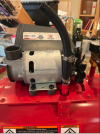- Joined
- Jun 3, 2019
- Messages
- 2,714
I have a HF 1/3 hp air compressor that I use in my garage to manage my car tire pressures (actually bought it for a cool mist system .... but it was woefully insufficient for that purpose) that after a couple years is now not reaching its shutoff pressure of 120psi. It runs, slowly, slowly, slowly increases tank pressure up to about 60psi, then goes no higher. technically I can use that to inflate car tires to about 34 psi or so .... but I am sure it can not be good/safe to keep the thing running so long.
this is an "oil-less" compressor. Does anyone know if there is a maintenance item or repair that might be done to this pump .... or with an oil less pump, if it fails in this manner is it just toast?????
this is an "oil-less" compressor. Does anyone know if there is a maintenance item or repair that might be done to this pump .... or with an oil less pump, if it fails in this manner is it just toast?????

